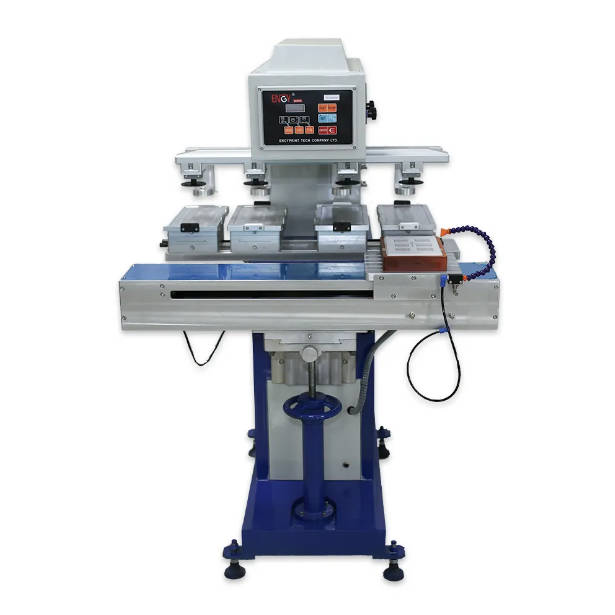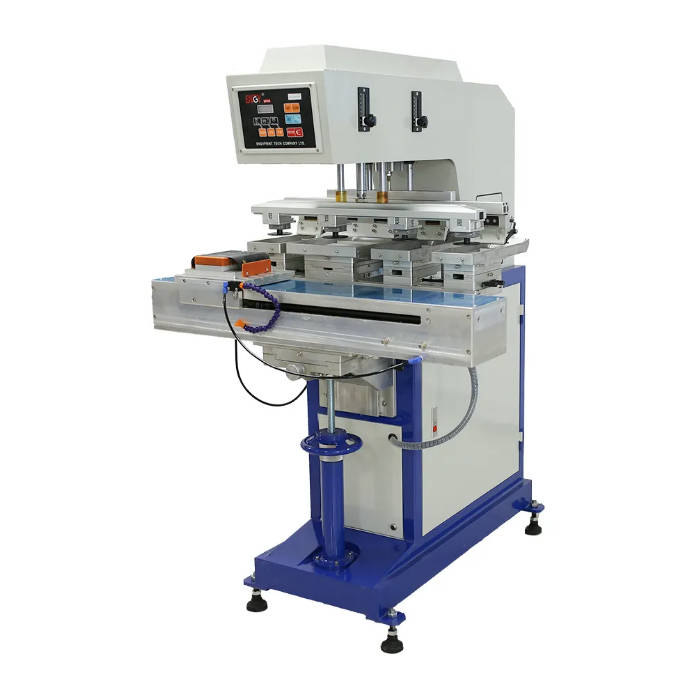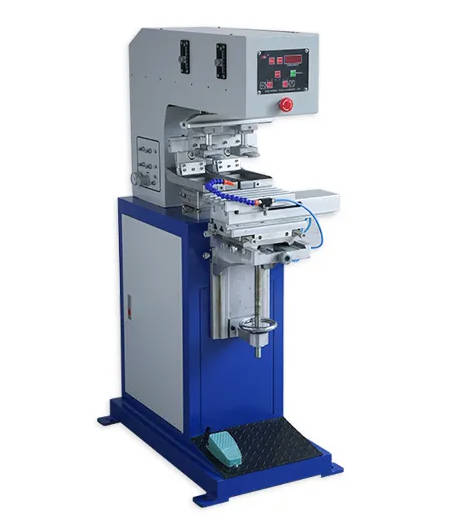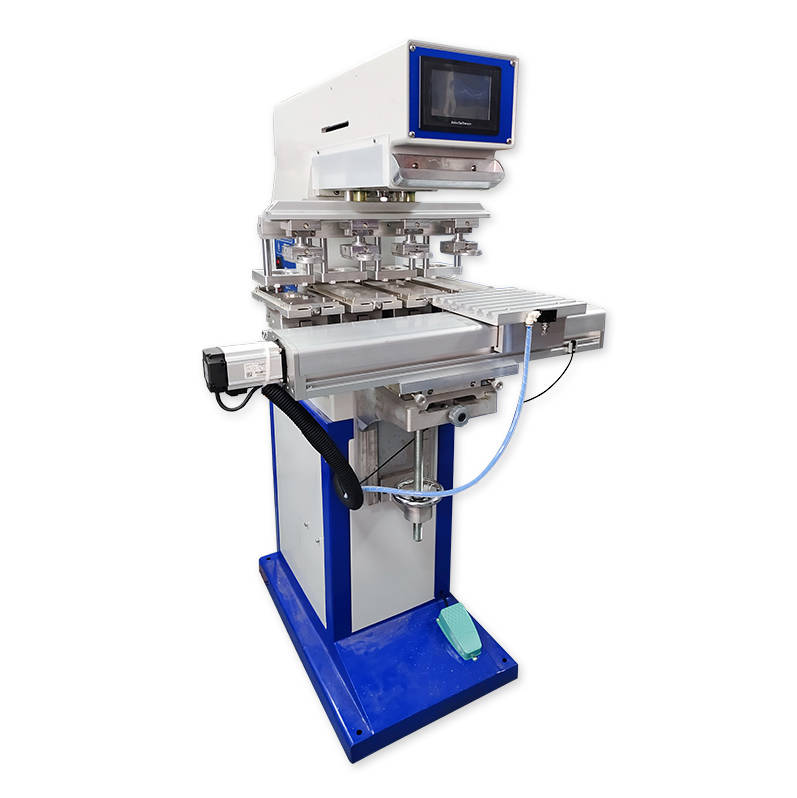Introduction
When it comes to decorating or labeling products with irregular shapes, one versatile solution stands out: the pad printing process, powered by a reliable Pad printing machine. This technology enables manufacturers to print sharp designs, text, or logos on curved, textured, and otherwise challenging surfaces. Companies in sectors such as automotive parts, medical devices, electronics, and promotional goods have long relied on pad printing for consistent and high-quality results. Yet, these outcomes depend heavily on how effectively you manage all aspects of the printing system.
For businesses aiming to enhance productivity and reduce wastage, achieving optimum ink transfer efficiency is a priority. Proper ink transfer ensures that the pad lifts the right amount of ink from the etched plate (also known as a cliché) and deposits it cleanly onto the product. By refining your processes—and by using the right pad printer supplies—you can minimize ink waste, boost color accuracy, and maintain uniformity across batches. This comprehensive article will delve into the fundamentals of pad printing, discuss critical factors that influence print quality, and offer strategic steps to calibrate and maintain your pad printing machine to get the best possible results.
Whether you are an experienced operator looking to enhance current workflows, or a newcomer seeking advice on purchasing a new pad printing machine, understanding each stage of the printing process is paramount. Through a combination of operator training, efficient setups, equipment maintenance, and informed product selection, you can achieve high transfer efficiency that simultaneously reduces operating costs and satisfies customer expectations.
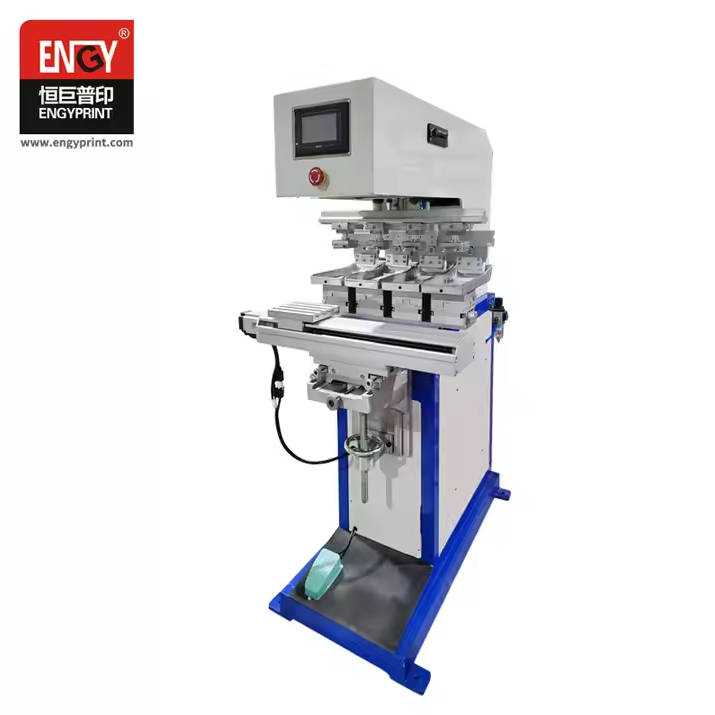
1. Fundamentals of Pad Printing
Pad printing is a unique method that combines elements of offset printing, screen printing, and stamping. The process begins with an etched plate carrying the desired artwork. This etched plate holds ink in its recessed cavities. A silicone pad presses onto the ink-filled recess, picks up the ink, and then transfers it onto the target substrate. The beauty of this technology lies in the pad’s flexibility; it can compress and conform to many shapes, a key advantage over more rigid printing systems.
A Pad printing machine consists of several key components working in unison:
- Etched Plate (Cliché): This plate has a precise, engraved recess of the image to be transferred. Its depth and clarity are crucial because they dictate the volume of ink that can be transported.
- Ink Cup or Ink Well: This holds the ink and distributes it onto the etched plate. The ink cup often includes a doctor blade or ring that removes excess ink from the plate’s surface, leaving ink only in the recessed area.
- Silicone Pad: The pad’s size, shape, and hardness (durometer) influence ink pickup and release. It also determines contact pressure and coverage on curved or uneven surfaces.
- Machine Pneumatics or Electrical Controls: These automate the pad’s movements, from pressing onto the plate to transferring ink onto the product. Speed, stroke length, and pressure are typical adjustable parameters.
- Product Fixture or Tooling: This device holds the product in place, helping ensure consistent contact between the silicone pad and the substrate.
Together, these elements form an integrated system that can print on an impressive variety of materials—whether it’s plastic, glass, metal, or ceramic. By configuring the machinery carefully, selecting the right pad printer supplies, and controlling environmental variables, manufacturers can expand their decoration capabilities beyond flat surfaces. And through methodical calibration, a pad printing machine sustains repeatable, high-quality prints, making it an indispensable tool in many manufacturing scenarios.
2. Concept of Ink Transfer Efficiency
Ink transfer efficiency measures how effectively the machine lifts ink from the etched plate and delivers it onto the product. A high transfer ratio means minimal waste, precise reusable printing pads, and a consistently accurate final design. This efficiency is not merely about ensuring a good-looking print; it directly impacts your bottom line. Wasted ink increases operational costs and raises the likelihood of reworks or rejects due to inconsistent coverage or blurred images. Consequently, businesses that optimize this figure often see a boost in production throughput and a decrease in material expenditure.
Several key factors govern ink transfer efficiency. First is the compatibility of the ink’s viscosity with the silicone pad and the etched plate’s recess depth. If the ink is too thick or too thin, the pad may not pick it up or release it effectively. Second is pad compression: a stable, well-aligned machine that delivers consistent pressure will yield uniform print results. Thirdly, the pad’s physical properties—such as its durometer or elasticity—strongly influence how the ink is lifted and transferred.
Finally, the environment in which the pad printing machine operates can also make a difference. Temperature swings or high humidity can alter the ink’s drying time, leading to insufficient or excessive ink retention on the pad. By recognizing each of these influences and implementing corresponding adjustments, businesses can significantly elevate their printing outcome. Properly managed, the printing process leads to a refined product appearance and nurtures brand reputation, especially when combined with reliable pad printer supplies.
3. Key Factors Affecting Ink Transfer
Achieving stable, high-quality prints from a Pad printing machine depends on multiple intertwined aspects. Below are the vital factors every operator or buyer should consider:
- Pad Material and Geometry:
- The silicone pad’s hardness (durometer rating) determines how well it conforms to shapes and how it releases ink. Softer pads often adapt better to curved surfaces but may distort intricate details. Firmer pads preserve fine lines more consistently, yet they are less flexible on complex substrates.
- The pad’s design (round, rectangular, or custom shapes) also influences how evenly pressure is distributed.
- Ink Composition:
- Different products demand inks with specific drying times, adhesion levels, and color fidelity. High-speed production settings often require fast-drying formulations, while items subjected to stress or chemical exposure may need specialized inks.
- Viscosity must be carefully balanced to ensure the pad picks up and drops off an optimal layer of ink. Thinning agents or hardeners may be necessary to refine ink performance under varying temperature and humidity levels.
- Plate Etch Depth and Clarity:
- A plate that is too shallow reduces the ink volume, leading to faded print. An overly deep one raises the likelihood of smudging or excess ink usage.
- The quality of engraving—whether laser or photochemically etched—also matters. Crisp edges on the plate produce sharper designs.
- Environmental Conditions:
- Ambient temperature and humidity can either speed up or slow down ink drying. If the pad picks up ink that dries too quickly, transfer efficiency declines. Conversely, overly tacky ink becomes messy and unpredictable.
- Ensure stable conditions in the printing area and consider climate control measures for sensitive environments.
- Consistency in Machine Operation:
- Fluctuations in stroke speed, pad dwell time, or pressure will generate inconsistent results. Regardless of your pad printer supplies, maintaining a stable process is crucial.
A comprehensive understanding of these components helps you detect and address inefficiencies before they affect production. By aligning your ink, pad, plate, and machine parameters, you can realize consistently high transfer rates and a robust return on investment.
4. Machine Setup & Calibration
Even the finest pad printing machine requires meticulous setup to achieve high transfer efficiency. Every micro-adjustment in pressure, stroke length, and pad angle can drastically change the outcome of a print cycle. Initial installation should include thorough alignment, ensuring the plate is level and the silicone pad makes uniform contact. In many modern machines, servo motors or precision pneumatic actuators control the pad’s motion, allowing operators to fine-tune speed settings.
Calibration typically proceeds as follows:
- Pad Compression: Determine how far you want the pad to compress against the plate and the product. Too little compression can result in incomplete ink pickup; too much can cause blurred images or premature pad wear.
- Ink Cup Pressure and Movement: The ink cup’s blade (doctor blade) must scrape the plate evenly, removing excess ink without damaging the surface. A well-sealed ink cup prevents evaporation and contamination.
- Print Cycle Speed: Balancing speed and dwell times is key. Moving too fast can lead to incomplete ink transfer, while moving too slowly risks partial drying of the ink on the pad.
- Test Prints and Adjustments: Produce several test prints, scrutinizing each for clarity and saturation. Document all parameters—pad hardness, stroke speed, ink brand, room temperature—so you can replicate successful settings later.
A standardized procedure for machine calibration ensures that operators have a reliable framework to follow. Whether using digital controls or manual adjustments, consistency in your approach cuts down on guesswork and leads to more predictable, high-quality results. Ultimately, efficient setup not only safeguards your investment in the pad printing machine but also helps you harness the full potential of your chosen pad printer supplies.
5. Maintenance & Cleaning
Long-term performance of a Pad printing machine hinges on diligent maintenance routines. Proper cleaning and part replacement schedules prevent accumulated residue or mechanical wear from degrading print quality. Regular inspections should include checking all contact surfaces—particularly the silicone pad and the etched plate—for signs of damage or contamination. Even the smallest flaws, like scratches or lint, can impair ink pickup and transfer.
Upkeep priorities often include:
- Ink Cup Hygiene: Residual ink can harden on the blade or inside the cup if not removed promptly. This residue typically causes uneven scraping, leading to inconsistent prints. Cleaning products specifically designed for pad printer supplies can help dissolve dried ink without damaging components.
- Plate Preservation: Over time, repeated use can dull or erode parts of the etched image, especially if the plate is not handled gently. Follow recommended guidelines for storing and cleaning plates to preserve image sharpness.
- Pad Care and Replacement: The silicone pad gradually loses elasticity with repeated compression and exposure to inks, eventually affecting print clarity. Maintain extra pads on hand and rotate them to extend each pad’s lifespan.
- Machine Lubrication: For models with mechanical moving parts, lubrication at designated intervals ensures smoother stroke movements and prevents friction that can disturb alignment.
- Environmental Monitoring: If you operate in a dusty or humid area, adjusting your cleaning frequency and possibly adding protective enclosures will guard vulnerable parts of the machine.
A structured maintenance program wards off breakdowns, giving you a consistent production schedule and stable results. All the best calibration and advanced ink formulations in the world will not compensate for neglect. By investing in good maintenance practices, you protect your machinery, ensure excellent ink transfer, and smooth out your production flow.
6. Troubleshooting Common Issues
Even with a well-maintained pad printing machine, occasional hurdles can arise. Identifying signs of trouble early and applying structured solutions will keep production moving smoothly. Here are a few commonly encountered problems:
- Incomplete or Faded Prints:
- Possible Cause: Ink viscosity may be too high, preventing proper transfer. Alternatively, the etched plate could be too shallow or partially clogged, limiting the volume of ink available.
- Solution: Adjust with the appropriate thinner or retarder, and carefully clean the etched plate. If the plate is worn, consider re-etching or replacement.
- Blurred or Double Images:
- Possible Cause: Excessive pad pressure or misalignment between the product and the pad. Rapid movements or vibration during the transfer can also blur details.
- Solution: Reduce compression and ensure stable product fixturing. Calibrate the machine’s stroke speed and clamp the substrate securely.
- Excessive Ink Residue on the Pad:
- Possible Cause: The ink may not be drying quickly enough, or the pad might be too soft. A poorly adjusted doctor blade can also leave more ink than intended in the plate recess.
- Solution: Modify the ink’s drying properties, consider a firmer pad, or recalibrate blade pressure.
- Uneven Color Saturation Across Prints:
- Possible Cause: Fluctuations in room temperature/humidity or inconsistent machine operation. Also, leftover contamination on the pad or plate can cause spotty coverage.
- Solution: Maintain stable environmental conditions; keep a close eye on the condition of your pad printer supplies (pads, plates, and inks). Clean and align all components meticulously.
Systematic troubleshooting starts with documenting print parameters and visually inspecting prints at regular intervals. By tracking variations in ink, pad, or environment, you can isolate the cause of defects more quickly. Remember also to check external factors—like mechanical vibrations or abrupt changes in air pressure—that might unexpectedly influence print quality. A methodical approach speeds up diagnostics, prevents repeated errors, and safeguards the efficiency and reliability of your pad printing machine.
7. Purchasing Considerations and Supplier Selection
When potential buyers first decide to incorporate a pad printing machine into their operations, they must consider numerous elements beyond price alone. The following factors are vital to selecting equipment that consistently delivers optimal ink transfer efficiency:
- Machine Capacity & Multi-Color Options:
- If you plan large-volume runs or multi-color prints, a more advanced system with servo-driven controls or automated pad cleaning may be worth the investment.
- Build Quality & After-Sales Support:
- A robust aluminum or steel chassis helps the machine withstand rigorous daily use. Also, assess warranties, training programs, and the manufacturer’s reputation for customer service.
- Compatibility with Existing Infrastructure:
- Evaluate the machine’s power requirements, environmental conditions, and footprints. Check whether you need added accessories, like UV dryers or ventilation systems.
- Available or Bundled Pad Printer Supplies:
- Some suppliers offer comprehensive packages with specialized inks, plates, and silicone pads. A one-stop shop approach can ensure all parts are designed to work harmoniously.
- Potential for Automation & Integration:
- If your long-term plan involves automating production lines or connecting multiple manufacturing steps, confirm that the machine has advanced interfaces or upgrade options.
Diligent research, site visits to trade shows, and requesting sample prints are all part of due diligence. By focusing on each machine’s reliability, speed of changeover, and access to quality pad printer supplies, you can make a more informed purchase. Ultimately, a carefully chosen system not only meets your immediate demands but provides headroom for future growth.
8. Conclusion
Optimizing ink transfer efficiency in any Pad printing machine is a multi-faceted endeavor. From fine-tuning pad durometer and ink viscosity to regularly maintaining the plate and ensuring stable machine calibration, each step supports safer, more predictable, and more cost-effective production runs. With informed choices in pad printer supplies—including specialized inks, dependable plates, and high-quality silicone pads—manufacturers can enhance print clarity, reduce scrap, and strengthen brand representation across a diverse array of products.
By comprehensively understanding how the core elements of pad printing interact, you can anticipate potential issues and implement consistent corrective measures. Tasks such as routine cleaning, environment stabilization, and standardized operator training underscore the continuous nature of improvement in this field. Whether you are a newcomer searching for a reliable first system or a seasoned manufacturer looking to upgrade existing machinery, making the right decisions at each phase—from selecting the right pad printing machine to establishing rigorous upkeep protocols—serves as the foundation for success.
As global competition intensifies, strong visual appeal and reliable product labeling become imperative. Harnessing the complete potential of pad printing contributes to superior product aesthetics, brand recognition, and a stable market reputation—assets that no modern business can afford to overlook.


